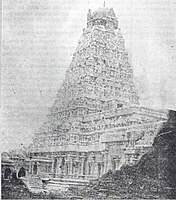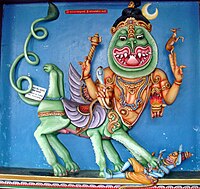
The Great Living Chola Temples is a UNESCO World Heritage Site designation for a group of Chola dynasty era Hindu temples in the Indian state of Tamil Nadu. The temple at Thanjavur was added in the list in 1987, while the other two temples were added in 2004.

The period of the imperial Cholas in South India was an age of continuous improvement and refinement of Chola art and architecture. They utilised the wealth earned through their extensive conquests in building long-lasting stone temples and exquisite bronze sculptures, in an almost exclusively Dravidian cultural setting.

Kulothunga III was a Chola emperor who ruled from 1178 to 1218 CE, after succeeding his elder brother Rajadhiraja II. Kulothunga Chola III gained success in war against his traditional foes. He gained victories in war against the Hoysalas, Pandyas of Madurai, Cheras of Venad, the Sinhalese kings of Polonnaruwa, as well as the Telugu Cholas of Velanadu and Nellore. He also restored Chola control over Karur, which were ruled by the Adigaman chiefs as vassals of the Cholas. He drove out the Hoysalas under Veera Ballala II who had made inroads in the Gangavadi and adjoining areas of Tagadur in Kongu country in an effort expand their territory. However, during the last two years of his reign, he lost in war to the resurgent Pandyas, heralded a period of steady decline and ultimately, demise of the Cholas by 1280 CE. Kulottunga III had alliances with the Hoysalas. The Hoysala king Veera Ballala married a Chola queen called Cholamahadevi and gave his daughter Somaladevi in marriage to Kulottunga III.

Dravidian architecture, or the Southern Indian temple style, is an architectural idiom in Hindu temple architecture that emerged from Southern India, reaching its final form by the sixteenth century.
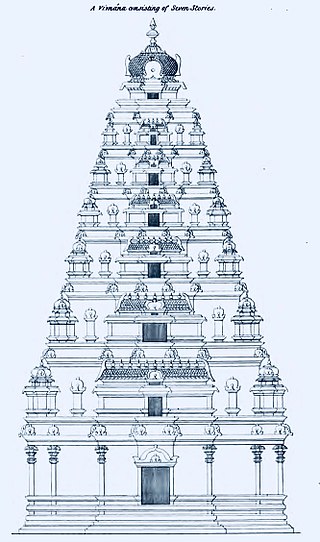
Vimana is the structure over the garbhagriha or inner sanctum in the Hindu temples of South India and Odisha in East India. In typical temples of Odisha using the Kalinga style of architecture, the vimana is the tallest structure of the temple, as it is in the shikhara towers of temples in West and North India. By contrast, in large South Indian temples, it is typically smaller than the great gatehouses or gopuram, which are the most immediately striking architectural elements in a temple complex. A vimana is usually shaped as a pyramid, consisting of several stories or tala. Vimana are divided in two groups: jati vimanas that have up to four tala and mukhya vimana that have five tala and more.

Airavatesvara Temple is a Hindu temple of Chola architecture located in Kumbakonam, Thanjavur District in the South Indian state of Tamil Nadu. This temple, built by Chola emperor Rajaraja II in the 12th century CE is a UNESCO World Heritage Site, along with the Brihadeeswara Temple at Thanjavur, the Gangaikondacholisvaram Temple at Gangaikonda Cholapuram that are referred to as the Great Living Chola Temples.

Thenupuriswarar Temple is a Hindu temple dedicated to the god Shiva located in the village of Patteeswaram, Tamil Nadu, India. Shiva is worshiped as Thenupuriswarar, and is represented by the lingam. His consort Parvati is depicted as Nyanambikai (Somakamalambigai). The presiding deity is revered in the 7th century Tamil Saiva canonical work, the Tevaram, written by Tamil saint poets known as the Nayanars and classified as Paadal Petra Sthalam. The temple is associated with the legend of Sambandar to whose view Nandi moved to have a direct view of the presiding deity. Muthupandal festival celebrated in the temple in associated with the legend.

Pazhayarai or Pazhaiyarai or Palayarai was an ancient capital of the medieval Chola dynasty in Tamil Nadu. The place is located around 7 km (4.3 mi) from Kumbakonam, a city in Thanjavur district, in the South Indian state of Tamil Nadu. It is located on the banks of T.Patnam river, one of the distributaries of the river Kaveri. There are a number of villages within the area of historic Pazhaiyarai. The place was called Ayiratalli, meaning a land of thousand temples. The place is referred under various names like Ayiratalli, Pazhayar, Ahavamallakulakalapuram and Minavanaivenkadasolapuram.
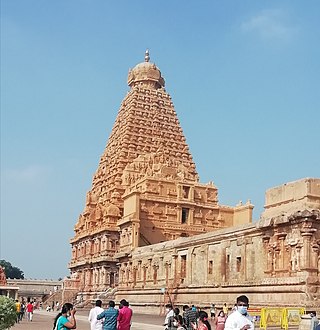
Brihadishvara Temple, called Rajarajesvaram by its builder, and known locally as Thanjai Periya Kovil and Peruvudaiyar Kovil, is a Shaivite Hindu temple built in a Chola architectural style located on the south bank of the Cauvery river in Thanjavur, Tamil Nadu, India. It is one of the largest Hindu temples and an exemplar of Tamil architecture. It is also called Dakshina Meru. Built by Chola emperor Rajaraja I between 1003 and 1010 CE, the temple is a part of the UNESCO World Heritage Site known as the "Great Living Chola Temples", along with the Chola-era Gangaikonda Cholapuram temple and Airavatesvara temple, which are about 70 kilometres (43 mi) and 40 kilometres (25 mi) to its northeast respectively.
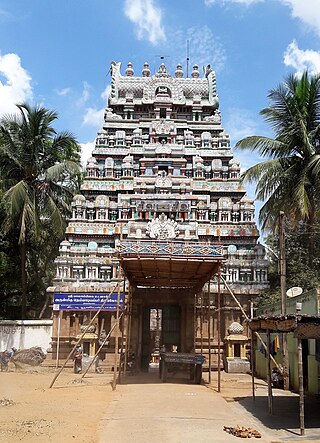
Neyyadiappar Temple, Tillaistanam is a Hindu temple dedicated to Shiva located in the village of Thillaisthanam also known as Tillaisthanam or Thiruneithanam in Tamil Nadu, India. It is significant to the Hindu sect of Shaivism as one of the Saptasthanam, the seven temples associated with Aiyarappar temple in Thiruvaiyaru. Shiva is represented by the lingam in the form of Neyyadiappar. His consort Parvati is depicted as Piraisoodi Amman. The presiding deity is revered in the 7th-century-CE Tamil Shaiva canonical work, the Tevaram, written by Tamil saint poets known as the nayanars and classified as Paadal Petra Sthalam.

Palaivananathar Temple is a Hindu temple dedicated to the deity Shiva, located in Papanasam, in Thanjavur district in the South Indian state of Tamil Nadu. Shiva is worshiped as Papanasanathar, and is represented by the lingam. His consort Parvati is depicted as Thavalavennayagal. The presiding deity is revered in the 7th century Tamil Saiva canonical work, the Tevaram, written by Tamil saint poets known as the Nayanars and classified as Paadal Petra Sthalam.
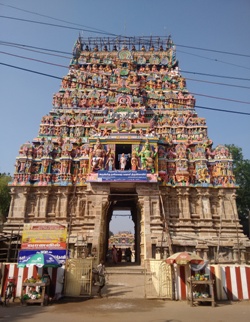
Nageswaraswamy Temple is a Hindu temple dedicated to Shiva located in Kumbakonam in Thanjavur district, Tamil Nadu, India. The presiding deity is revered in the 7th-century Tamil Saiva canonical work, the Tevaram, written by Tamil poet saints known as the nayanars and classified as Paadal Petra Sthalam. The temple is counted as the earliest of all Chola temples. Shiva in the guise of Nagaraja, the serpent king..
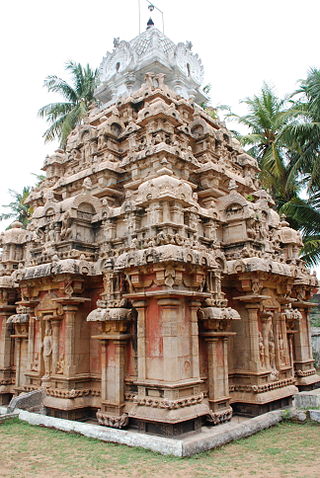
Tirupullamangai or Thirupullamangai is a Hindu temple dedicated to Lord Siva located at Pullamangai, in Pasupathikoil, Papanasam taluk of Thanjavur district, Tamil Nadu, India. It is one of the shrines of the 275 Paadal Petra Sthalams - Shiva Sthalams glorified in the early medieval Tevaram poems by Tamil Saivite Nayanar Tirugnanasambandar.
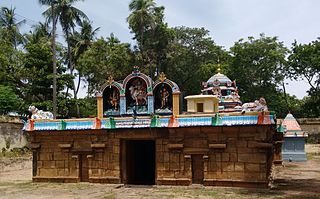
Chakramangai or Chakravageswarar Temple is a Hindu temple dedicated to Hindu deity Shiva and is located in Chakkarapalli, Papanasam taluk of Thanjavur district, Tamil Nadu, India. The temple is incarnated by the hymns of Thevaram, the 7th century Tamil literature and is classified as Paadal Petra Sthalam. It is one of the 275 Paadal Petra Sthalams, where the three of the most revered Nayanars, Appar and Tirugnana Sambandar have glorified the temple with their verses during the 7th-8th century. The temple has been widely expanded by Chola kings during the 11th century.
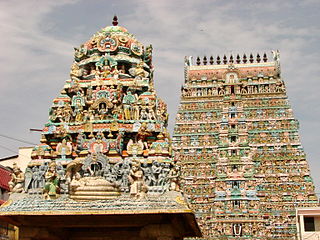
Tamil Nadu is known for its ancient temple architecture. Nearly 33,000 ancient temples, many at least 800 to 2000 years old, are found scattered all over Tamil Nadu. As per Tamil Nadu Hindu Endowments Board, there are 38,615 temples. Most of the largest Hindu Temples are located in Tamil Nadu. Studded with complex architecture, a variety of sculptures, and rich inscriptions, the temples remain the very essence of the culture and heritage of Tamil land, with historical records dating back to at least 3,000 years.
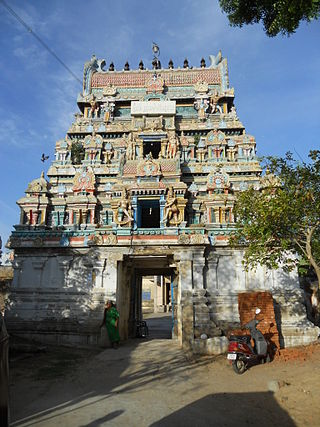
Padikasu Nathar Temple is a Hindu temple located at Azhagaputhur, a village in the Thanjavur district of Tamil Nadu, India. Shiva is worshiped as Padikasunathar, and is represented by the lingam. His consort Parvati is depicted as Soundaranayagi. The presiding deity is revered in the 7th century Tamil Saiva canonical work, the Tevaram, written by Tamil saint poets known as the nayanars and classified as Paadal Petra Sthalam. The 8th century Saiva saint poet Sundarar has sung praise about the temple in his works.

Pazhaiyarai vadathali Temple, or Pazhaiyarai Vadathali is a Hindu temple dedicated to Someswarar, a form of Shiva. It is located 6 km from Kumbakonam, Tamilnadu, India, on the Kumbakonam- Aavoor Road, 2 km away from the Thenupuriswarar Temple at Patteeswaram and 3 km from Darasuram. It is served by buses from Kumbakonam or mini buses from Darasuram, the bus stop is Cholan Maligai. The Darasuram railway station is located close to the temple.

Kapardeeswarar temple is a Hindu temple situated in the village of Thiruvalanchuzhi near Swamimalai in Kumbakonam taluk of Thanjavur district, Tamil Nadu, India. Shiva is worshiped as Kapardeeswarar and is represented by the lingam and his consort Parvati is depicted as Brihannayagi. The presiding deity is revered in the 7th century Tamil Saiva canonical work, the Tevaram, written by Tamil poet saints known as the nayanars and classified as Paadal Petra Sthalam.

Kailasanathar Temple, is a Siva temple in Udaiyalur at Kumbakonam takuk in Thanjavur District in Tamil Nadu (India).


